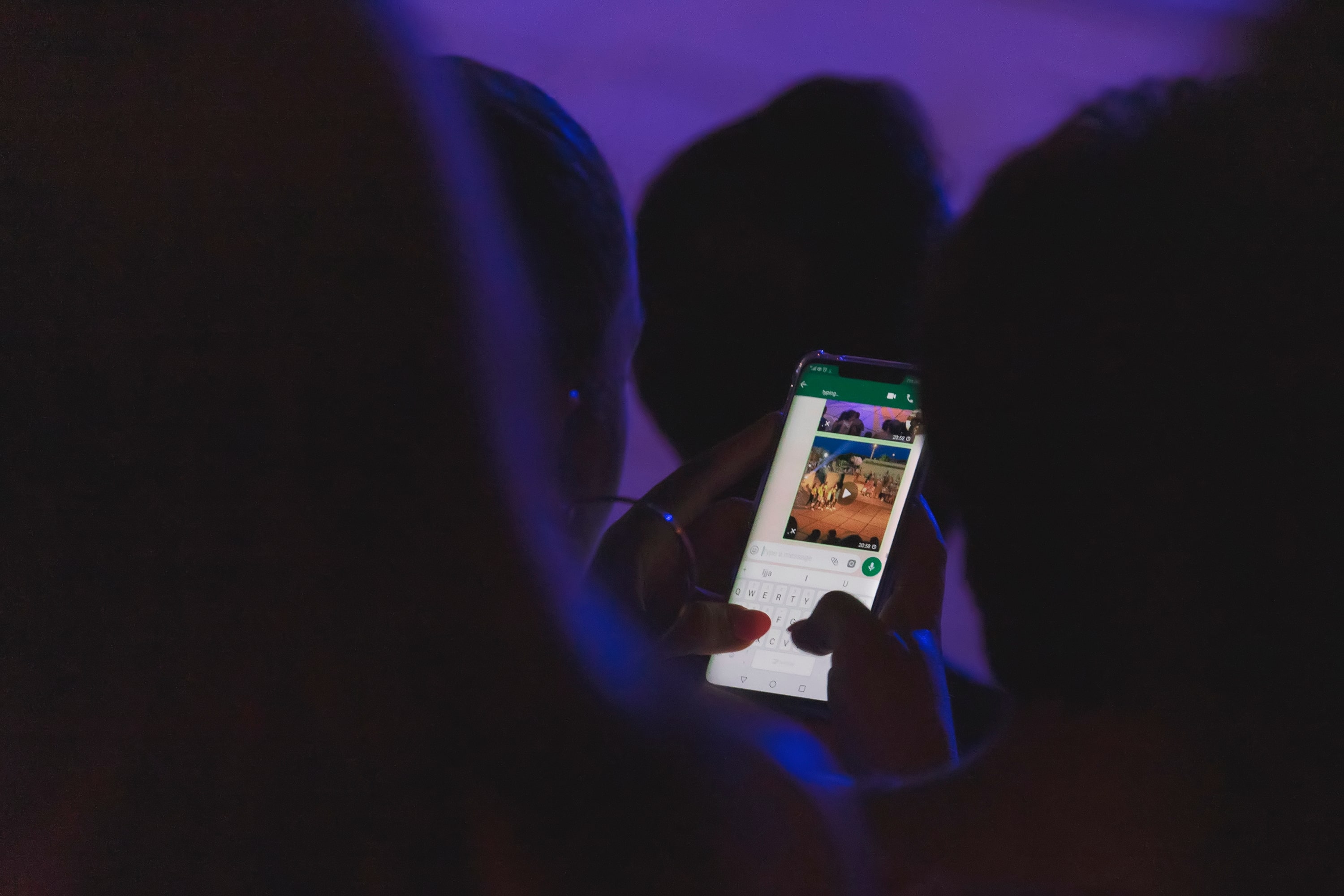Key Takeaways
- Evening blue light exposure reduces your body’s ability to respond to glucose and increases insulin resistance.
- Frequent exposure is linked to a higher risk of type 2 diabetes.
- Timing matters: morning light improves insulin sensitivity, while evening light disrupts normal metabolism.
- Simple tools like blue light blocking glasses, warm bulbs, and blackout curtains can protect circadian rhythms and help optimize blood sugar.
{{mid-cta}}
Everyone knows the classic advice: put down your phone before bed if you want better sleep. But here’s the twist nobody’s talking about: blue light doesn’t just sabotage your shut-eye. It can also disrupt your metabolism and blood sugar regulation.
Yep. That late-night scroll might be messing with your glucose as much as your sleep.
How Blue Light Hijacks Your Metabolism

Blue light isn’t just “light;” it’s a biological signal. Short-wavelength, high-energy light pours out of the screens and LEDs that surround us 24/7. During the day, that signal is useful: it tells your brain to stay alert, suppresses melatonin, and keeps your circadian rhythm aligned with sunlight.1
The problem? At night, your body expects darkness. That’s when your circadian clock cues melatonin to rise, insulin sensitivity to shift, and your metabolism to prepare for rest and repair.1 Blue light after dark scrambles those signals.
Here’s what happens when your eyes pick up blue light at night:
- Melatonin gets shut down. Instead of winding down, your brain thinks it’s midday.3 Sleep is delayed, shallower, and less restorative.
- Appetite hormones go haywire. Ghrelin (the hunger hormone) climbs, leptin (the fullness signal) drops, and late-night cravings hit harder.
- Blood sugar regulation stalls. Your body becomes less responsive to insulin, making post-meal glucose levels rise higher and stay elevated longer.
That misalignment adds up. When your circadian rhythm is consistently thrown off, your body is essentially running on the wrong schedule: storing energy when it should be burning it, elevating glucose when it should be stable, and priming long-term risk for type 2 diabetes, obesity, and cardiovascular disease.2,3
Light isn’t background noise; it’s one of the most powerful levers your metabolism listens to. Ignore it, and your glucose control pays the price.
What the Research Says
Here’s where the science gets undeniable: the impact of blue light isn’t subtle. Both lab studies and population-level data show real metabolic consequences.
- Brightness matters. One study found that for every 10-lux increase in evening light exposure (that’s just a slight uptick in brightness), the risk of developing type 2 diabetes jumped by 30%.4
- Even short exposure is enough. Just one hour of blue light at night was shown to impair glucose tolerance during an oral glucose tolerance test.5 Translation: your body struggles to clear sugar from the bloodstream after a meal, even if you’re otherwise healthy.
- City lights, city risks. People living in brightly lit urban environments, where artificial light floods bedrooms and streets all night, show higher rates of obesity and type 2 diabetes.9 And these links hold even after accounting for diet, BMI, and physical activity.9
This means the danger isn’t just pulling an all-nighter on social media; it’s the everyday drip of artificial light cues that mislead your metabolism. The signal your brain should get from sunrise and sunset is blurred by late-night scrolling, Netflix binges, or even that bright bathroom bulb.
Bottom line: blue light isn’t harmless background glow. It’s a metabolic disruptor powerful enough to alter hormones, spike glucose swings, and raise chronic disease risk over time.
Timing Is Everything

Your metabolism runs on light cues. The timing of that light matters just as much as the type.
- Morning light is medicine. Exposure to natural sunlight in the first few hours of the day acts like a master reset for your circadian clock. It boosts insulin sensitivity, stabilizes appetite hormones, and locks your body into a healthy rhythm.3,4 Morning light tells your brain: it’s time to be alert, burn energy efficiently, and keep glucose stable.
- Evening light is a disruptor. Artificial light after sunset flips that script. It delays melatonin release, blunts glucose tolerance, and shifts your body toward storing energy instead of burning it.3,4 Your metabolism reads that blue light signal as daytime (even when it’s midnight) and starts running on the wrong schedule.
Think of it this way: light is a metabolic fuel.
- Morning light is clean fuel that tunes up your system.
- Evening light is contaminated fuel that clogs your engine.
That mis-timing doesn’t just impact one night of sleep. Over weeks and months, it compounds, affecting glucose control, appetite, and long-term metabolic health.
Real-World Impact
Here’s the reality: modern life has us swimming in blue light long after sunset. Overhead LEDs. TV screens. Laptops glowing late into the night. The phone you “just check for five minutes” before bed.
Layer that on top of common nighttime habits (late-night snacks, high stress, inconsistent sleep) and you’ve got a perfect storm for glucose chaos. Your body is trying to wind down, but the environment is screaming “daytime.”
The most vulnerable group? Shift workers. Research shows that people who work nights or rotating schedules face significantly higher rates of type 2 diabetes, obesity, and heart disease.8 And the risk isn’t just small; long-term shift work can double the odds of developing metabolic disease.8
But here’s the kicker: you don’t need to work the night shift to feel the impact. Even a couple of hours of screen time in the evening (Netflix, emails, doomscrolling) can chip away at your metabolic resilience. The result? Higher glucose spikes after dinner, more cravings at night, and less restorative sleep to recover.
Light is a variable you control. And how you time it might matter as much as what’s on your plate.
How to Protect Your Metabolism from Blue Light

You don’t need to go full caveman to protect your circadian rhythm. The goal isn’t zero light; it’s smarter light. A few small adjustments can flip the signal your body is getting from “chaos” to “calm.”
- Dim your screens after sunset. Most phones, laptops, and TVs now have a “night shift” or blue-light filter setting. Use it. It won’t make your Instagram feed look like a candlelit dinner, but it will cut the harsh wavelengths that disrupt melatonin.
- Swap your bulbs. Bedrooms and living spaces are the worst spots for bright white LEDs at night. Warm amber or red-spectrum bulbs give enough light for comfort without blasting your brain with a fake sunrise.
- Try blue-blocking glasses. Especially if you’re glued to a laptop in the evening, these are an easy, portable fix. Studies show they reduce melatonin suppression and improve sleep quality.
- Power down early. Aim to shut off major devices at least an hour before bed. That’s not about restriction; it’s about recovery. That final hour in darkness helps your glucose regulation reset for tomorrow.
- Seek morning light on purpose. Step outside within an hour of waking; no sunglasses, no glass window between you and the sky. Just 10–20 minutes of direct daylight is one of the most powerful circadian resets you can give your body. It boosts insulin sensitivity, sharpens focus, and locks your internal clock to the natural day/night cycle.
When you treat light like nutrition (feeding your body the right wavelengths at the right times), you support metabolism just as much as you do with food and exercise.
A Metabolism-Friendly Evening Routine
Want a simple blueprint? Think of your evening environment as “training wheels” for your circadian rhythm. Each step cues your brain and metabolism that the day is done and recovery mode is on.
- Sunset: As daylight fades, dim your overhead lights. Switch to side lamps or floor lamps with warm bulbs. If possible, let natural darkness lead the way.
- Dinner: Eat under softer, warmer light instead of glaring LEDs. It’s not just about ambience; it’s about avoiding the hormonal chaos of eating under bright, blue-rich light.
- Wind-Down: Put the laptop and phone away. Swap screens for low-stim activities: stretching, journaling, reading, or conversation. Bonus points if you use candles, salt lamps, or amber bulbs to reinforce that nighttime cue.
- Bedtime: Give your brain total darkness. Blackout curtains, eye masks, or even a strip of electrical tape over blinking chargers make a huge difference. True darkness lets melatonin peak, glucose stabilize, and your body move into deep, restorative sleep.
None of this has to feel rigid. These rituals aren’t about perfection; they’re about consistency. By stacking small cues together, you create an environment that helps your metabolism run the way it’s designed to: aligned, efficient, and resilient.
Metabolic Playbook: Morning vs. Evening Light

Morning Light, Do This:
- Get 10–20 minutes of outdoor daylight within an hour of waking (no sunglasses, no windows in between).
- Work out near a window or outside if you can.
- Open blinds wide; let natural light flood your environment.
Morning Light, Avoid This:
- Staying in dim indoor light all morning (your circadian clock won’t reset).
- Reaching for screens before you’ve seen real daylight.
Evening Light, Do This:
- Dim overhead LEDs and switch to warm, amber lighting.
- Use “night shift” or blue-light filter on your phone/laptop after sunset.
- Create a wind-down window, screen-free for at least 1 hour before bed.
Evening Light, Avoid This:
- Bright white LEDs in kitchens/bedrooms.
- Last-minute Netflix binge or doomscroll right before bed.
- Eating late-night snacks under bright lights (double hit: glucose and light disruption).
The Bottom Line
Blue light isn’t just a sleep thief; it’s a metabolic disruptor. Evening exposure blunts glucose control, reduces insulin sensitivity, and raises long-term disease risk.
The upside? You can take control. By dimming screens, prioritizing morning light, and choosing warm nighttime lighting, you protect not just your sleep, but your metabolism.
Just like food and movement, light is a lever. Pull it wisely, and your glucose (and your health) thank you.
Learn More with Signos’ Expert Advice
Signos incorporates cutting-edge research and the proven power of continuous glucose monitoring to help you reach your health goals. Check out more articles on our blog.
Topics discussed in this article:
References
- https://www.sciencedirect.com/science/article/abs/pii/S0091302222000012
- https://pubmed.ncbi.nlm.nih.gov/38157962/
- https://www.e-dmj.org/journal/view.php?number=2879
- https://www.sciencedirect.com/science/article/pii/S2590142725000096
- https://pmc.ncbi.nlm.nih.gov/articles/PMC6811685/#phy214257-sec-0002
- https://pubmed.ncbi.nlm.nih.gov/26950542/#:~:text=A%20logistic%20regression%20model%20was,duration;%20sleep%20health;%20snoring.
- https://www.nature.com/articles/s41598-020-76636-8
- https://bmcendocrdisord.biomedcentral.com/articles/10.1186/s12902-024-01808-w
- https://pmc.ncbi.nlm.nih.gov/articles/PMC12221600/


.jpg)

.svg)










.svg)
.svg)
.svg)
.svg)
.svg)
.svg)
.svg)
